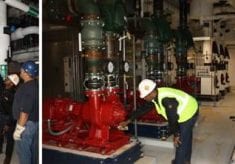Water-source heat pumps help preserve historic building
The vintage building presented challenges for the design and installation of the HVAC system.
The Icon 1616 luxury apartments in downtown Philadelphia opened in 2014 after a complete renovation of the former office building into a Class-A multifamily community.
Built in 1929, the 25-story Art Deco structure is listed on the U.S. National Register of Historic Places and now accommodates 206 apartments ranging in size from one to three bedrooms in addition to penthouses on the top two floors. Among other amenities, the facility features a fitness center, club-room with kitchen, and a sky deck.
Finding a solution
“Property owners were seeking economical WSHP solutions for residences that could accommodate tight, compact spaces and had low maintenance and low noise,” says Eric Voegele, project manager with A.T. Chadwick Co. mechanical contractors in Bensalem, Pennsylvania.
“The vertical stack WSHPs are an efficient system and also inexpensive to purchase and install,” says Andrew Doble, engineering sales manager and Daikin Applied representative with Tristate HVAC in West Conshohocken, Pennsylvania. He also notes the vintage building presented challenges for the design and installation of the HVAC system.
“The project required significant coordination before ordering the equipment to ensure a proper fit,” he says.
Mechanical contractors encountered their first challenge before installation even began when they determined the low ceiling height in the fourth-floor gym and daycare area couldn’t accommodate the vertical stack WSHPs.
“As an alternative, we specified 16 Daikin AC ceiling-mounted water-source VRV units with piping to supply hot and cold air without ductwork,” Doble says.
Voegele noted that apartment space constraints entailed significant planning to install the 280 vertical stack WSHPs in the apartments — as well as 40 horizontal WSHPs for penthouse suites — before major finishing occurred.
“All of the apartment floors have narrow floor-to-ceiling heights at 10.5 feet, so getting the vertical stack WSHP units into the spaces required careful maneuvering and coordination with various construction crews.”
Installations occurred June through September of 2013 and were done in small groups with cabinet/piping installations in one stage, chassis in another, and final finishing in a third stage. An exterior hoist car was used by the mechanical installers to lift the WSHPs into the building.
Outcome
Icon 1616 is a great example of an efficient WSHP installation and space-conditioning solution for property owners and residents alike.
“The overall coordination among parties went very well for a fast-tracked job with tight schedules,” Voegele says.
The building has been occupied for more than one year, and A.T. Chadwick has fielded only minor service calls on the WSHPs.
“All the units have been heating and cooling properly, and we have not heard any complaints about residents being too hot or cold,” he says.




















Recent Comments